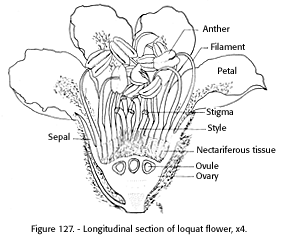LOQUAT
Eriobotrya japonica (Thunb.) Lindl., family RosaceaeThe loquat is also called Japanese plum, Japanese medlar, and rush orange. It is not grown commercially to any extent for its fruit in the United States (Campbell 1965), but it is a common southern dooryard and ornamental plant. It will do well wherever lemons grow.
Plant:
The loquat is a rather long-lived symmetrical evergreen to 25 feet tall, with oblong, stiff dark-green leaves 8 to 12 inches in length (Bailey 1949*). Condit (1915) recommended that the plants be spaced 12 feet apart in the row, and rows 24 feet apart for commercial production.
The fruit, which ripens in the spring, can be damaged by slightly below freezing temperatures (Mowry et al. 1967*). The 1- to 3-inch pear- shaped fruits, four to 10 per cluster, have three to five seeds, and yellow flesh. They are used fresh or in preserves or jams and in making a delicious jelly (Kennard and Winters 1960*). There are many cultivars in Florida, some trees of which may yield as much as 300 pounds fruit (Campbell 1965).
Inflorescence:
The name "Eriobotrya" (Greek: woolly inflorescence) refers to the profusion of small woolly flowers born in a terminal dry-bracted panicle. Flowering occurs from October to February, sometimes in up to three flushes of blooms in a season. The second one usually sets the most fruit (Chandler 1958*). Blossoms in the northern part of Florida and similar regions seldom bear fruit because of cold injury. Bees visit the blossoms freely for nectar and pollen. A copious quantity of nectar may collect in the open cavity around the ovary, below the base of the anthers. In warmer areas of China, the loquat is reported to be the principal source of surplus honey in November (Pellett 1947*).
There are 10 to 50 small fragrant white flowers in a panicle, only about 12 percent of which develop into fruit. Each flower has five petals, five stigmas, about 20 stamens, and five carpers (fig. 127). Each carper has two ovules; therefore, 10 seeds may develop, although rarely more than three to five do so (Smock 1937, Campbell and Malo 1968). Thinning of fruit may be necessary if the set is too heavy, but usually the set is too light for economic production.

Pollination Requirements:
The pollination requirements seem to vary with cultivars of loquat, but all are benefited by, and some require, cross-pollination. Crescimanno (1958) reported that even individual cultivars vary widely from year to year in the amount of fruit set through self-pollination. He found that bagged blossoms set only 0.0, 16.5, and 1.3 percent; whereas, open blossoms set 4.2, 12.0, and 21.7 percent; and crossed flowers (the last 2 years) set 60 and 55 percent of the blossoms. High temperatures seem to be detrimental to fruit set. This could be the result of a decreased period of stigma receptivity or pollen viability associated with inadequate pollinator activity. Mortensen and Bullard (1968*) reported that cross- pollination was beneficial to all varieties and necessary in some. Kennard and Winters (1960*) also reported that the flowers are self-incompatible, so several trees should be planted close together to assure cross- pollination.
The details of the flowers' period of receptivity is not known, however Singh (1963) found that pollen will remain viable 35 to 45 days at room temperature, 22 months at 0deg C., and 26 months in a deep freeze.
Pollinators:
Nothing is mentioned in the literature about the pollinating agents for loquat. However, honey bees visit the flowers freely and are usually the primary visitors. Presumably, they are satisfactory pollinating agents.
Pollination Recommendations and Practices:
None. Where maximum fruit set is desired, plants should probably be in close proximity and bees should be present in abundance during flowering.
LITERATURE CITED:
CAMPBELL, C. W.
1965. THE WOLFE LOQUAT. Fla. Agr. Expt. Sta. Cir. S-170,6 pp.____ and MALO, S. E.
1968. THE LOQUAT. Fla. Agr. Ext. Serv., Fruit Crops Fact Sheet 5,2 pp.CONDIT, I. J.
1915. THE LOQUAT. Calif. Agr. Expt. Sta. Bul. 250: 251-284.CRESCIMANNO, F. G.
1958. [INVESTIGATIONS ON THE FLORAL BIOLOGY OF THE LOQUAT.] Riv. Orto-florofruttic Ital. 83: 107-120. [In Italian.] Abstract in Plant Breed. 28(4): 821. 1958.SINGH. S. N.
1963. STUDIES ON THE LONGEVITY OF LOQUAT POLLEN. Trop. Agr. [Ceylon.] 119: 31-36.SMOCK, R. M.
1937. MORPHOLOGY OF THE FLOWER AND FRUIT OF THE LOQUAT. Hilgardia 10(16): 615-627.
